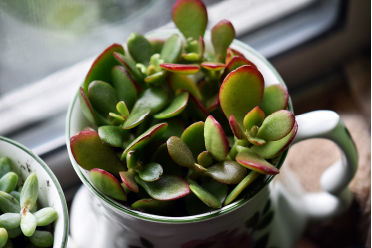ONE GARDENER TO ANOTHER: Jade plants a nice addition to any home
Published 6:30 am Monday, September 4, 2017

- Jade plant
There was a point in my life where it seemed that everyone I knew was buying a house. I suppose that when the bulk of your friends are relatively the same age, this would make sense.
Most often, it was a couple that had been married within the past few years and were now putting down roots.
Trending
With the purchase of their new home came the announcement of this joyous event and an invitation to join the happy couple at their new residence for a housewarming party. This event, much like the shower and the wedding I attended, requires a gift. Ugh! I have given coffee table books, decorative bowls, even an umbrella stand (this one came about because I helped the couple move in one rainy day, and not wanting to put my soaking wet umbrella inside on their hardwood floors, left it on the porch, where it blew away).
Beside the umbrella stand, I had the vision that as soon as the party was over, most of the trinkets that were received that day were packed away or re-gifted at a housewarming party to a friend that was not a mutual acquaintance.
Inevitably, another invitation came in the mail, and as I was looking around my home for inspiration for a gift, my eyes landed on my Jade plant. This was the first houseplant that I had bought that lived. Jade plants are known as “the friendship tree,” “the money plant” and “the lucky plant.” It was perfect and became the housewarming gift that every single person who sent me an invite received from then on.
Jade plants are a succulent plant, with thick woody stems and plump, oval, jade-colored leaves. Although a succulent, they are not as drought-tolerant as other succulent species, so the soil should be kept relatively moist but not wet. If the leaves start shedding or develop brown spots, that is a sign that the plant needs more water.
Water thoroughly until water runs through the holes at the bottom of the pot. Be sure to allow the water to drain completely and empty the drip tray so the plant does not sit in water.
A clay pot is ideal for jade plants because the pot will absorb water which helps the soil dry out easier and reduces the chances of overwatering. General potting soil can hold too much moisture, so a mixture of coarse sand, potting soil and perlite is a good mix that helps with drainage.
Trending
Jade plants require at least four hours of sunlight each day. They grow best at a room temperature of 65˚-75˚F, but prefer cooler temperatures such as 55˚F at night and in the winter. In the winter, move plants away from cold window panes and out of the path of cold drafts to avoid cold damage.
Jade plants live very well outside during the summer but are sensitive to sunburn. It is important when moving your plant outdoors to do it gradually. If your jade plant does live outdoors for the summer, be sure to bring it back in before the first frost.
Jade plants should be fertilized approximately every three to four months with a liquid houseplant fertilizer. Avoid watering with fertilizer when the soil is dry, as this will damage the roots. Water regularly and then water the plant with fertilizer. Do not apply fertilizer for at least three to four months to newly started plants.
Since the stems are usually very thick, the plant can become top-heavy, so when planting, plan ahead and plant in a wide and sturdy pot. Although the plant does not mind being root-bound, if the plant outgrows its pot and does become top-heavy, transplant when new growth starts. Let the soil dry before repotting.
Jade plants make a beautiful and easy to care for addition to any home, and they make for a really nice gift. Until next week – happy gardening!
— Irland, a member of the Limestone County Master Gardeners, can be reached at kippirland@hotmail.com. For more information on the Limestone County Master Gardeners, visit http://mg.aces.edu/limestone.






